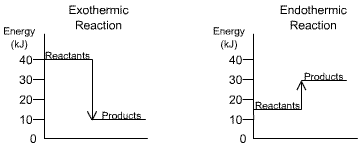Energy Transfer in Chemical Reactions
For example, when fireworks burn they give out energy in the form of light, heat and sound.
Exothermic Reactions
In an exothermic reaction energy is given out, usually in the form of heat.
This can often be detected by a rise in temperature.
Exothermic reactions are very common. For example:
- burning fuels
- respiration
- in neutralisation reactions, such as reacting an acid with a metal or an alkali
- when water is added to anhydrous copper sulphate
anhydrous copper sulphate + water ![]() hydrated copper sulphate [+ heat]
hydrated copper sulphate [+ heat]
(white) (blue)
This colour change is used as a test for water.
Endothermic Reactions
In an endothermic reaction energy is taken in, often as heat, from the surroundings.
This can often be detected by a fall in temperature.
Endothermic reactions are not very common.
Some examples are:
- thermal decomposition, e.g., calcium carbonate has to be heated strongly to make it decompose
calcium carbonate calcium oxide + carbon dioxide
calcium oxide + carbon dioxide - photosynthesis takes in light energy
dissolving some salts in water
Reversible Reactions
If a reaction is exothermic in one direction, then it will be endothermic in the opposite direction.
The same amount of energy is transferred in each case.
hydrated copper sulphate [+ heat energy] ![]() anhydrous copper sulphate + water
anhydrous copper sulphate + water
The forward reaction has to be heated. It takes in energy, so is endothermic.
The reverse reaction is exothermic and gives out heat.
Energy Level Diagrams
Energy must be supplied to break bonds.
Energy is released when bonds are formed.
In an exothermic reaction, the energy released from forming new bonds is greater than the energy needed to break existing bonds.
In an endothermic reaction the energy needed to break existing bonds is greater than the energy released from forming new bonds.
These energy changes can be shown in an energy level diagram.

|
The products have less energy than the reactants. |
The products have more energy than the reactants. |
|
30 kJ of energy has been given out. |
15 kJ of energy has been taken in. |
|
The reaction is exothermic. |
The reaction is endothermic. |
Bond Energy Calculations
Another method to calculate the amount of energy transferred is by using known bond energy values.
Every chemical bond has a particular bond energy, no matter what compound the bond occurs in.
The equation for burning hydrogen in air is:
2H2 + O2 ![]() 2H2O
2H2O
This can be written using the structural formulae of the chemicals involved.
2 (H-H) + O=O ![]() 2 (H-O-H)
2 (H-O-H)
The bond energies involved are:
|
Bond |
Bond Energy (kJ) |
|
H-H |
436 |
|
O=O |
498 |
|
O-H |
464 |
Before the reaction can take place the bonds between the atoms in the hydrogen and oxygen must be broken.
Energy taken in to break bonds:
The bonds on two molecules of hydrogen and one molecule of oxygen have to be broken.
2 x H-H = 2 x 436
= 872 kJ
O=O = 498 kJ
Total energy taken in = 872 + 498
=1370 kJ
Energy given out from forming bonds:
There are two O-H bonds in each water molecule.
Two molecules of water are formed, therefore four O-H bonds are formed altogether.
4 x 464 = 1856 kJ
More energy is given out than is taken in, so the reaction is exothermic.
For this reaction the amount of energy given out is 1856 – 1370 = 486 kJ
Activation Energy
Many reactions need some energy to get them going.
The minimum amount of energy required is called the activation energy , and is often shown on energy level diagrams.
The amount of activation energy does not affect the overall energy change for the reaction. It is not included in the calculation.
When a catalyst is used the reaction proceeds faster because it lowers the amount of activation energy required, so more collisions will be successful.

The graphs show the energy transfer for the same chemical reaction.
When a catalyst is used the activation energy is less, but the overall energy transfer is the same. In this example 20 kJ of energy is given out
Document Actions

 Like us on Facebook
Like us on Facebook